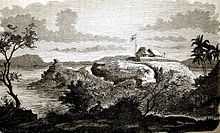Sibolga
Coordinates: 1 ° 44 ' N , 98 ° 47' E
Sibolga (former name Siboga) is a port city on the west coast of the island of Sumatra in Indonesia . It lies between 1 ° 42 'and 1 ° 46' north and 98 ° 44 'to 98 ° 48' east on the west side of the province of Sumatra Utara (North Sumatra) on the Indian Ocean , about 209 km south of the provincial capital Medan .
geography
Sibolga has an area of 3356.60 ha, which consists of 1126.9 ha of mainland on Sumatra, 238.32 ha of islands and 2171.6 ha of sea area. Islands that belong to the city of Sibolga are Pulau Poncan Gadang, Pulau Poncan Ketek, Pulau Sarudik, and Pulau Panjang.
The administrative structure consists of three Kecamatan (sub-districts) and 16 Kelurahan (local parishes):
- Sibolga Utara with four Kelurahan
- Sibolga Kota with four Kelurahan
- Sibolga Selatan with eight Kelurahan
In the east the city borders on the province of Tapanuli Tengah, in the west on the Bay of Tapian Nauli. The Sungao River runs through the urban region. The bay is so protected by protruding headlands and the offshore island of Musala that the tsunami of 2004 did not cause any significant damage despite the relatively close earthquake epicenter .
Demographics
The population of the city is based on the census of the statistical office Sibolga. In 2008, 94,616 inhabitants were counted. With a core area of 644.53 hectares, the city's population density is 14,680 inhabitants per square kilometer. The annual population growth is 1.99 percent.
The manufacturing economy essentially comprises fishing and tourism companies, shipyards and port facilities as well as services. The main catches of the fishery are groupers , tuna , sardines and anchovies .
Mayor is Sahat Pinorshinta Panggabean; The representative mayor is Afifi Lubis.
history

Pulau Poncan Ketek (Little Poncan Island) in Tapian Nauli Bay was once a fortified trading post. British, Dutch, French and American traders came here. In 1820, at the time Luitenant Governor of Bengkulu in South Sumatra, Stamford Raffles visited this island to learn about Batak customs from the crew of the trading post . In the following years Pulau Poncan Ketek became the most important starting point for missionaries and naturalists for their journeys to the southern Batak lands on Sumatra.
In 1834 two missionaries of the American "Boston Missionary" were killed by locals not far from Sibolga. Franz Wilhelm Junghuhn , "The Humboldt of Java", explored Sumatra from Sibolga on behalf of the Dutch colonial administration between 1840 and 1842.
Ludwig Ingwer Nommensen , the so-called "father of the Batak", created the basis of the Barmer Mission from Barmen. Missionary Schrey headed the subsequent mission station in Sibolga.
In 1898 Sibolga was struck by a great fire disaster. The city was rebuilt with wider and shady streets. Another fire disaster on January 23, 1913 reduced the newly built market district to rubble and ashes; the rebuilding of this quarter took several years.
Transport and tourism
Sibolga is a stopover in trade. From here ferries serve the islands of Simeulue and Nias . Other destinations are also served, such as the port of Padang, some 380 km further south . Furthermore Sibolga is an important station of the Trans-Sumatran Highway which km northeast across Tarutung to about 160 remote Lake Toba , south across Padang Sidempuan for a 360 km distant city of Bukittinggi leads.
The picturesque bay of Tapian Nauli with numerous islands, as yet uncrowded sandy beaches and little-visited coral gardens could become an attractive destination for tourists, if not the remote location of Sibolga on Sumatra's “outside” and the unhealthy, humid climate with over 200 rainy days and up to 4500 millimeters of annual precipitation would counteract this development. In the middle of the 20th century, Sibolga was so plagued by malaria that the Dutch colonial government at the time wanted to move its resident's seat inland to a higher location.
Sibolga is the seat of a Catholic diocese .
Web links
- Sibolga Information (Indonesian)
